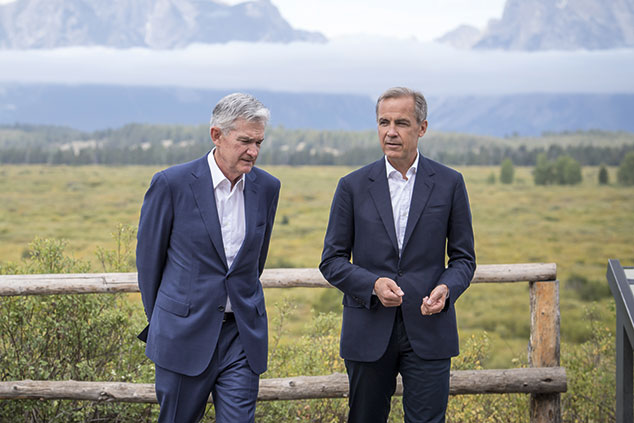
What is a reserve currency?
It’s a currency that central banks (or other government monetary authorities) around the world choose to hold in significant quantities as part of their reserves of foreign exchange. Currently, and since the middle of the 20th century, the dominant reserve currency is the US dollar, accounting for around 61.7% of foreign currency reserves (according to the IMF’s figures for 2018). The euro is the next most popular reserve currency with around 20.7%, followed by the Japanese yen on 5.2%, sterling on 4.4%, and the Chinese renminbi on 1.9%. The primacy of the US dollar reflects the overwhelming decades-long dominance of the US economy, the centrality of the US to global networks of trade, and the belief that US government debt is an exceptionally safe asset. A third of countries peg their own currency to the US dollar, and around half of world trade is denominated in dollars.
Is this situation likely to be permanent?
Nothing lasts for ever. The Greek drachma, first coined in the fifth century BC, the Roman denarius, and the Byzantine solidus – all functioned as “international” hard currencies. The same goes for the Arab dinar in the middle ages, the Venetian ducato and Florentine florin in the Renaissance era, and the French franc and Dutch guilder in the 17th century. In the 18th century the guilder became the dominant currency thanks to the Netherlands’ dominance of world trade. But in its modern sense, the idea of a global reserve currency dates from the mid-19th century, with the development of central banks and rapid integration of the global economy. In the 1860s, Britain was the world’s biggest exporter and source of foreign investment, and the centre of global finance, and sterling, backed by gold, was the global reserve currency. It was superseded by the US dollar in the 20th century – a fact formalised under the Bretton Woods system in the wake of World War II. The dollar remains king, though the link with gold ended in 1971.
How did the financial crisis affect things?
Paradoxically, a global financial crisis that had its seeds in the US actually strengthened the dominance of the dollar. So strong is the belief in US Treasuries as the world’s safest asset that investors sought the dollar as a haven from the maelstrom in world financial markets. “The custodian of the primary reserve currency was rewarded by foreign money for grotesquely mismanaging its own financial system,” as John Plender puts it in the Financial Times. The dollar’s survival as the primary reserve currency despite America’s shrinking share of the global economy reflects “the extraordinary liquidity of the Treasury market” and the US central bank’s success since the 1980s at keeping inflation under control.
Is this a big advantage for the US?
Overall, having the global reserve currency is definitely an advantage. America accounts for a hefty but declining share of world trade. Yet its status as issuer of the global reserve currency amplifies its power – it allows it to freeze geopolitical rival Iran out of global financial markets, for example. The dollar’s status also means that the US has much lower borrowing costs that it otherwise would (a position famously dubbed America’s “exorbitant privilege” in the 1960s by France’s then finance-minister Valéry Giscard d’Estaing).
Is the dollar’s dominance about to end?
Some commentators think so. A combination of long-term trends and short-term politics makes it seem more likely now than it has for some time. Although the dollar remains entrenched for now, the political dominance of the US, and its share of the global economy, are waning. The world is becoming more multi-polar, and the logic of that process – however long run and gradual it proves to be – is that the dollar’s days as the undisputed global reserve currency are numbered. One factor likely to speed that process up is the growing disconnect between the needs of the US and the developing world in terms of monetary policy and a growing fear that under its current president, Donald Trump, the US is undermining hard-won trust accumulated over more than a century.
How is the US undermining trust?
Trump’s attempts to bully the Federal Reserve into cutting interest rates, his tax cuts for the rich and corporations – which have seen the budget deficit expand to a level unprecedented in peacetime – and his trade war against China and threats made against allies have all spooked governments and financial markets, says Ian King in The Times. His actions are “undermining the liberal, rules-based order, which was built by America and has driven the world’s post-war prosperity”. If Trump continues to abuse the dollar’s reserve status, and if the international rules-based order fragments, we are likely to see the rise of other reserve currencies, such as the euro or the renminbi.
Are there other options?
Last month Bank of England chief Mark Carney floated the idea of using electronic money as a de-facto reserve. This would act as a “synthetic hegemonic currency” that would be made up of a “network of central-bank digital currencies” – and could “dampen the domineering influence of the US dollar on global trade”. In other words, there would be no need for countries to hoard dollars to guard against potential capital flight (an insurance policy that leads to excess savings and lower global growth) and US shocks would no longer reverberate around the world. “The deficiencies of the international monetary and financial system have become increasingly potent,” warns Carney. “Even a passing acquaintance with monetary history suggests that this centre won’t hold.” A passing acquaintance with monetary history also suggests, of course, that the key beneficiary of a turbulent transition to a new global currency regime will be gold. Accepted as a safe haven and store of value for thousands of years, it is in effect the world’s oldest reserve currency.